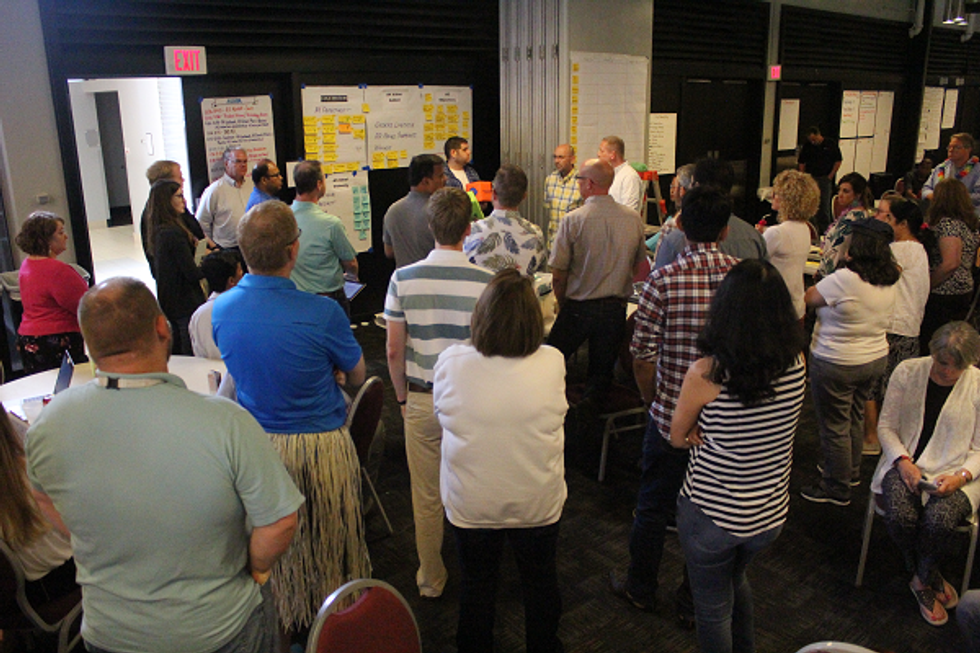Below is an article originally written by PowerToFly Partner Homecare Homebase. Go to Homecare Homebase's page on PowerToFly to see their open positions and learn more.
Homecare Homebase (HCHB) provides a powerful Software as a Service (SaaS) & Platform as a Service (PaaS) solution for home health and hospice agencies to run their practice. With the company's proprietary software at their fingertips, practitioners can focus on what's most important: patient care. While the tools simplify and streamline every administrative task for health workers, the coordination that makes that innovation possible is anything but simple.
HCHB has grown steadily over the last 17 years through careful coordination among many teams of software engineers. Within the last year, the company has implemented cutting-edge collaborative processes known as the Scaled Agile Framework (SAFe), to efficiently build their software products.
Off-site planning
The company hosts six off-site planning events annually where all agile teams present their progress, discuss issues, align on goals, and determine next steps and team dependencies. It's crucial that teams identify any potential problems beforehand because one team's innovations can affect the work of many others.
"Prior to the event, the product team gets together and comes up with what they want to achieve in the next release, everybody then comes to this event to map out the next eight weeks," says Cheri O'Neil, Director of the company's Program Management Office.

During the event, each team points out ways to improve, and identifies where they must collaborate to produce seamless upgrades without breaking the work of other teams through their next development sprints.
"This has provided a great benefit to getting commitment while there's also less churn — less starting and stopping of work," says Sam High, company Chief Technology Officer. "Once you commit on this event, you're locked and loaded for the next eight weeks. Our product works in a very integrated fashion, so it takes a lot of joint planning between our mobile products, our back office products and our ancillary products."
The teams
Each of HCHB's agile teams has a colorful name. Some are functional descriptors and others are poetic or humorous, like Smartinis, Thunderous Mammals, and Nerf Herders.
Derwin White, a software engineer who's been with Homecare Homebase for about two and a half years, explains the name of his team, Clinically Clouded Madness: "We're facilitating interoperability through the cloud for the first time. We weren't sure how we were going to do it, so that's where the madness comes in."
Prior to his move to Homecare Homebase, White worked on internal systems for insurance and security companies. "Here, which is very hard to find in Louisville, we get to actually work on the product." It's a challenge, he says. Any problem with the software is a problem with the product itself, not an inconvenience behind the scenes. That's why SAFe methodologies, which identify problems before they happen and keep the work of 20 distinct teams in sync, have been so beneficial.
After each team presents its work, members huddle to identify any dependencies within the next development stages. Each interoperable function where dependencies lie is illustrated by connecting teams' noted tasks and projects with pieces of yarn across a 10-foot-tall board.

Over the course of the next eight weeks, as goals are met and potential problems are averted through careful collaboration, the post-it notes and the yarn connecting them are removed from the board.
Like planning a marathon race
Of the SAFe methodology, O'Neil says it is like planning a marathon race with various groups working in cooperation. "You have your course plan and your date, so then you need to get a team on the blocking of the roads. One group manages the starting line, and one handles the finish line. Another team handles water breaks. In the end, the runners enjoy a carefully-engineered and seamless experience."
It's the same idea at Homecare Homebase. The coordination that results from the SAFe planning event directly impacts the technology. As White explains it, "The quality of our product has definitely improved. You can see the benefits of the [SAFe] process."
At the root of all this work is the knowledge that the HCHB platform drastically improves the quality of care practitioners can deliver. With less time devoted to tasks like logging therapy goals, billing, scheduling, routing, and CMS compliance, there is more time for face-to-face interaction between patients and healthcare workers. In 2018, HCHB will have brought their mission of empowering exceptional care to over 500,000 patients daily. Through ever-improving methodologies and innovation, that number of lives they touch can only grow.



